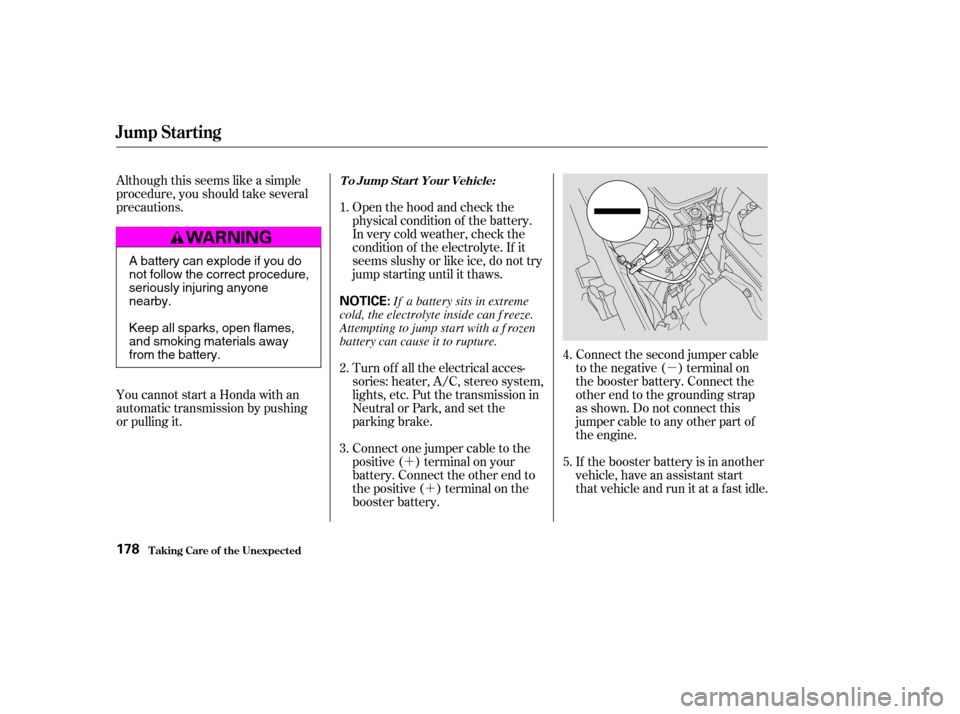Page 175 of 221

Diagnosing why your engine won’t
start f alls into two areas, depending
on what you hear when you turn the
key to START (III):You hear nothing, or almost
nothing. The engine’s starter
motor does not operate at all, or
operates very slowly.
You can hear the starter motor
operating normally, or the starter
motor sounds like it is spinning
f aster than normal, but the engine
does not start up and run. When you turn the ignition switch to
START (III), you do not hear the
normal noise of the engine trying to
start. You may hear a clicking sound
or series of clicks, or nothing at all.
Check the transmission interlock.
If you have a manual transmission,
the clutch pedal must be pushed
all the way to the f loor or the
starter will not operate. With an
automatic transmission, it must be
in Park or Neutral.
Turn the ignition switch to ON (II).
Turn on the headlights and check
their brightness. If the headlights
are very dim or don’t light at all,
the battery is discharged. See on page . Turn the ignition switch to START
(III). If the headlights do not dim,
check the condition of the f uses. If
the f uses are OK, there is
probably something wrong with
the electrical circuit f or the
ignition switch or starter motor.
You will need a qualif ied
technician to determine the
problem (see
on page ).
Check these things:
If the headlights dim noticeably or
go out when you try to start the
engine, either the battery is dis-
charged or the connections are
corroded. Check the condition of
the battery and terminal connec-
tions (see page ). You can
then try jump starting the vehicle
f rom a booster battery (see page).
178 167
190
178
If Your Engine Won’t Start
T aking Care of t he Unexpect ed
Nothing Happens or the Starter
Motor Operates Very Slowly
Jump Starting Emergency T owing
176
�����—�����—�����y�
�������������y���
�(�����������y���
�����y
Page 176 of 221
In this case, the starter motor’s
speed sounds normal, or even f aster
than normal, when you turn the
ignition switch to START (III), but
the engine does not run.Are you using a properly coded
key? An improperly coded key will
cause the immobilizer system
indicator in the dash panel to blink
rapidly(seepage ).
Are you using the proper starting
procedure? Ref er to on page . Do you have f uel? Check the f uel
gauge; the warning light may not
be working.
There may be an electrical
problem, such as no power to the
f uel pump. Check all the f uses
(see page ).
If youfindnothingwrong,youwill
need a qualif ied technician to f ind
the problem. See
on page .
125 68 186 190
If Your Engine Won’t Start
T he Starter Operates Normally
Starting the
Engine Emergency
Towing
T aking Care of t he Unexpect ed177
�����—�����—�����y�
�������������y���
�(�����������y���
�����y
Page 177 of 221

�´�´ �µ
Although this seems like a simple
procedure, you should take several
precautions.
You cannot start a Honda with an
automatic transmission by pushing
or pulling it. Open the hood and check the
physical condition of the battery.
In very cold weather, check the
condition of the electrolyte. If it
seems slushy or like ice, do not try
jump starting until it thaws.
Turn of f all the electrical acces-
sories: heater, A/C, stereo system,
lights, etc. Put the transmission in
Neutral or Park, and set the
parking brake.
Connect one jumper cable to the
positive ( ) terminal on your
battery. Connect the other end to
the positive ( ) terminal on the
booster battery.
Connect the second jumper cable
to the negative ( ) terminal on
the booster battery. Connect the
other end to the grounding strap
as shown. Do not connect this
jumper cable to any other part of
the engine.
If the booster battery is in another
vehicle, have an assistant start
that vehicle and run it at a fast idle.
1. 2. 3.
4. 5.
Jump Starting
T aking Care of t he Unexpect ed
To Jump Start Your Vehicle:
178
NOTICE:
A battery can explode if you do
not follow the correct procedure,
seriously injuring anyonenearby.
Keep all sparks, open flames,
and smoking materials away
from the battery. If a battery sits in extreme
cold, the electrolyte inside can f reeze.
Attempting to jump start with a f rozen
battery can cause it to rupture.
�����—�����—�����y�
�������������y���
�(�����������y���
���
�y
Page 179 of 221

Saf ely pull to the side of the road.
Put the transmission in Neutral or
Park, and set the parking brake.
Turn of f all accessories, and turn
on the hazard light.
If you see steam and/or spray
coming f rom under the hood, turn
of f the engine. Wait until you see
no more signs of steam or spray,
then open the hood.If you do not see steam or spray,
leave the engine running and
watch the temperature gauge. If
the high heat is due to overloading,
the engine should start to cool
down almost immediately. If it
does, wait until the temperature
gauge comes down to the midpoint,
then continue driving.
If the temperature gauge stays at
the red mark, turn of f the engine.Look f or any obvious coolant leaks,
such as a split radiator hose.
Everything is still extremely hot,
so use caution. If you f ind a leak, it
must be repaired bef ore you
continue driving (see
on page ).
If you don’t f ind an obvious leak,
check the coolant level in the
radiator reserve tank. Add coolant
if the level is below the MIN mark.
1. 2.
3. 4.5. 6.
190
If Your Engine Overheats
T aking Care of t he Unexpect ed
Emergency
Towing
180
�����—�����—�����y�
�������������y���
�(�����������y���
�����y
Page 181 of 221

This light should never
come on when the engine is
running. If it starts f lashing
or stays on, the oil pressure has
dropped very low or lost pressure.
Serious engine damage is possible
and you should take immediate
action. Saf ely pull of f the road, and shut
of f the engine. Turn on the hazard
warning indicators.
Let the vehicle sit f or a minute.
Open the hood, and check the oil
level (see page ). An engine
very low on oil can lose pressure
during cornering and other driving
maneuvers.
If necessary, add oil to bring the
level back to the full mark on the
dipstick (see page ).
Start the engine, and watch the oil
pressure indicator. If it does not go
out within ten seconds, turn of f
the engine. There is a mechanical
problem that needs to be repaired
bef ore you can continue driving.
(See on page
). If the charging system
indicator comes on brightly
when the engine is running,
the battery is not being charged.
Immediately turn of f all electrical
accessories. Try not to use other
electrically operated controls such as
the power windows. Keep the engine
running; starting the engine will
discharge the battery rapidly.
Go to a service station or garage
where you can get technical
assistance.
1. 2. 3. 4.
115
190 144
L ow Oil Pressure Indicator, Charging System Indicator
T aking Care of t he Unexpect ed
L ow Oil Pressure Indicator
Emergency T owingCharging System Indicator
182
NOTICE:
Running the engine with low
oil pressure can cause serious
mechanical damage almost immediately.
Turn of f the engine as soon as you can
saf ely get the vehicle stopped.
�����—�����—�����y�
�������������y���
�(�����������y���
�����y
Page 183 of 221

However, if the brake pedal does not
f eel normal, you should take
immediate action. A problem in one
part of the system’s dual circuit
design will still give you braking at
two wheels. You will f eel the brake
pedal go down much f arther bef ore
the vehicle begins to slow down and
you will have to press harder on the
pedal.
Slow down by shif ting to a lower
gear, and pull to the side of the road
when it is saf e. Because of the long
distance needed to stop, it is
hazardous to drive the vehicle. You
should have it towed and repaired as
soon as possible (seeon page ).
If you must drive the vehicle a short
distance in this condition, drive
slowly and caref ully.
The brake system indicator
normally comes on when
you turns the ignition
switch ON (II) and as a
reminder to check the
parking brake. It will stay lit
if you do not f ully release
the parking brake.
If the brake system indicator comes
on while drivinig, the brake f luid
level is probably low. Press lightly on
the brake pedal to see if it f eels
normal. If it does, check the brake
f luid level the next time you stop at a
service station (see page ).
If the f luid level is low, take the
vehicle to your dealer and have the
brake system inspected f or leaks or
worn brake pads. 190
151
Brake System Indicator
Emergency
Towing
T aking Care of t he Unexpect ed184
Canada U.S.
�����—�����—�����y�
�������������y���
�(�����������y���
�����y
Page 185 of 221

The under-hood f use box is located
onthepassenger’ssidenexttothe
battery.Turn the ignition switch to LOCK
(0). Make sure the headlights and
all other accessories are off.
Remove the cover f rom the f use
box.
Check each of the large f uses in
the under-hood f use box by
looking through the top at the wire
inside. Remove the screws with a
phillips-head screwdriver.
The vehicle’s f uses are located in
two fuse boxes. The interior fuse
box is located underneath the
steering column. To open it, turn the
knobsasshown.
If something electrical in your
vehicle stops working, check f or a
blown f use f irst. Determine f rom the
chart on pages and or the
diagram on the f use box lid, which
f uses control that device. Check
those fuses first, but check all the
f uses bef ore deciding that a blown
f use is the cause. Replace any blown
f uses, and check if the device works.1. 2. 3.
189
188
Fuses
T aking Care of t he Unexpect ed
Checking and Replacing Fuses
186
UNDER-HOOD
TAB
INTERIOR
FUSE
BLOWN
�����—�����—�����y�
���������
���y���
�(�����������y���
�����y
Page 187 of 221
�µ
�µ
�µ
No. Amps. Circuits Protected
1 23456789
1011121314151617181920 20 A
15 A
7.5 A 20 A
10 A
15 A
15 A
20 A
10 A
40 A
30 A
40 A
40 A
40 A
20 A
20 A
20 A
80 A
40 A Condenser Fan
Small Light
Interior Light
Cooling Fan
Hazard
FI ECU
Horn, Stop
ABS F/S
Back Up
ABS Motor
Rear Defroster
Heater Motor
Power Window
Option
Lef t Headlight
Door Lock
Right Headlight
Not Used
Battery
Ignition 1
Spare Fuses
21 257.5A 30A
Fuse Locations
T aking Care of t he Unexpect ed188
UNDER-HOOD FUSE BOX
�����—�����—�����y�
�������������y���
�(�����������y���
���
�y